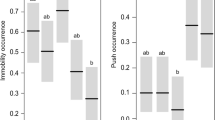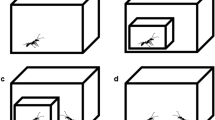Abstract
Assessment of parasite load of conspecifics may be important during social interactions such as courtship and aggressive encounters. We used a correlational study to test whether pheromonal markers can be used to assess parasite load of conspecifics, and whether the parasite load of the pheromone receivers affected their responses. We tested the responses of parasitized and nonparasitized Ozark zigzag salamanders, Plethodon angusticlavius, to territorial markers (fecal pellets) from conspecific males. Males and females were simultaneously exposed to fecal pellets placed in front of two artificial burrows located at the opposite ends of their chambers. The treatments were (1) fecal pellet of male with low parasite load versus fecal pellet of male with high parasite load, (2) fecal pellet of male with low parasite load versus control pellet (chemical blank), and (3) fecal pellet of male with high parasite load versus control pellet. Nonparasitized females spent significantly more time near fecal pellets of males with low parasite load in test condition 1, whereas the behavior of parasitized females was not significantly different from random in any test condition. Males responded differently to treatments only in condition 3; males with low parasite loads spent significantly more time near control pellets, whereas males with high parasite loads spent significantly more time near fecal pellets of males with high parasite loads. This study demonstrates that pheromonal markers may be used for assessment of parasite load of conspecifics and that responses by both males and females may be influenced by their own level of infection.
Similar content being viewed by others
Author information
Authors and Affiliations
Additional information
Received: 21 January 1999 / Received in revised form: 17 March 2000 / Accepted: 13 November 2000
Rights and permissions
About this article
Cite this article
Maksimowich, D., Mathis, A. Pheromonal markers as indicators of parasite load: parasite-mediated behavior in salamanders (Plethodon angusticlavius). acta ethol 3, 83–87 (2001). https://doi.org/10.1007/s102110000037
Issue Date:
DOI: https://doi.org/10.1007/s102110000037




